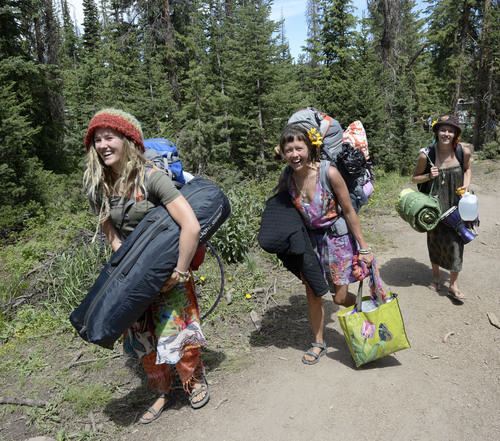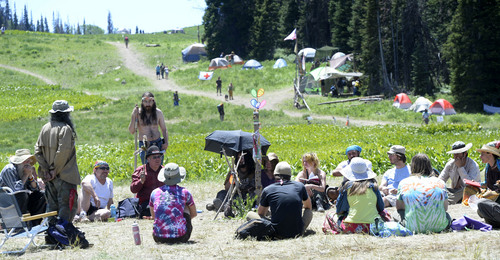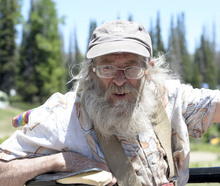This is an archived article that was published on sltrib.com in 2014, and information in the article may be outdated. It is provided only for personal research purposes and may not be reprinted.
With a little rain and new grass, you might not even know the Rainbow Family Gathering even happened.
As one could imagine, the gathering's amassing pilgrims make a mess of the Uinta National Forest that they occupy until 8,000 of them arrive for the annual culminating prayer circle on July 4.
Grass is trampled, trails are blazed, impromptu latrines are dug, kitchens and a stage are erected — a make-shift town arises in a forest. But after all the praying and dancing is over, what happens next?
"They always leave a cleanup crew," said Kathy Jo Pollock, spokeswoman for the U.S. Forest Service, on Wednesday. "They have started rolling up clothes, sorting the garbage — they do recycle. They were filling in the slit trenches and latrines, breaking up the fire rings, putting rocks back where they had found them… As you can imagine, 8,000 people make a lot of fire rings."
The attendees impacted about 1,300 acres, between the parking areas, the couple of miles of hiking trails used to reach the gathering, and the meeting area itself, Pollock said. The gathering's crew has to rehabilitate the area before they can leave, she said.
"People were concerned how some of the forage was walked on and pushed on. That will come back on its own [with some rain]," Pollock said.
Forest Service officials said it cost the agency about $500,000 in staffing costs to handle a counterculture group's annual gathering, according to the Associated Press.
Everyone but the clean-up crew is expected to leave this week; if not, they eventually have to, or the Forest Service will remove them.
The forest has a two-week camping limit, but that's hard to enforce on growing throngs of people with no formal organization or leadership, Pollock said. It's also hard to track that many people and their length of stay, she said, adding that most of the attendees were not there beyond the time limit.
"They have the right to assemble. We just deal with the issues," she said.
Now that the gathering is over and at least 85 percent of the attendees have left, that limit took effect on Monday for anyone who isn't part of the cleanup crew, Pollock said.
There are a few other Rainbows, though, who are not going home just yet: they are inmates of the Wasatch County Jail. Arrests at the gathering, estimated in the dozens, pushed the inmate population at the jail to capacity or near-capacity for several days.
Among the inmates is Leilani Novak-Garcia, 33, also known as "Hitler," who was charged in 4th District Court with second-degree felony attempted murder for allegedly stabbing a man in the head and shoulder who was trying to get her to stop honking her car horn at about 1 a.m. on June 23. During the same episode, Novak-Garcia allegedly stabbed another man in the arm, for which she has been charged with aggravated assault. A preliminary hearing is scheduled for later this month.
Deputy Wasatch County Attorney McKay King said the woman reportedly struck yet another person with a tire iron, but the alleged victim was never found.
Law enforcement also investigated two deaths, the cause of which remain unknown. Timothy R. Gillespie, 68, of Texas, was found dead in his tent on June 29, and Susan M. Wilkinson, 39, of Keene, N.H., died June 15 while sleeping outdoors.
Forest Service officers issued 136 citations, 195 warnings, and documented 225 other incidents in which either a citation or warning would be warranted, but no one was around to cite.
Twitter: @mikeypanda







